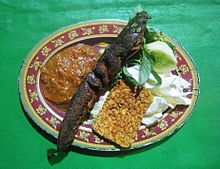bio.wikisort.org - Animal
Clarias is a genus of catfishes (order Siluriformes) of the family Clariidae, the airbreathing catfishes. The name is derived from the Greek chlaros, which means lively, in reference to the ability of the fish to live for a long time out of water.[1]
| Clarias Temporal range: Lower Pliocene - recent | |
|---|---|
 | |
| Walking catfish, Clarias batrachus | |
| Scientific classification | |
| Kingdom: | Animalia |
| Phylum: | Chordata |
| Class: | Actinopterygii |
| Order: | Siluriformes |
| Family: | Clariidae |
| Genus: | Clarias Scopoli, 1777 |
| Type species | |
| Silurus anguillaris Linnaeus, 1758 | |
| Species | |
|
Many, see text. | |
| Synonyms | |
| |
Taxonomy
Clarias has been found to be paraphyletic. A species of Heterobranchus (H. longifilis) clusters deeply inside the Clarias group.[2]
Distribution
They are found in inland waters throughout much of the Old World, and are one of the most widespread catfish genera in the world.[3][4] The genus is found in Southeast Asia and East Asia westwards through India and the Asia Minor to Africa.[5] The diversity of these catfishes is highest in Africa.[6] Some (notably the walking catfish) have become pest species where they have been accidentally introduced, and particularly in Cuba, where their introduction was intentional.
Description
Clarias species are recognized by their long-based dorsal and anal fins, which give them a rather eel-like appearance. These fish have slender bodies, a flat, bony head, and a broad, terminal mouth with four pairs of barbels. They also have a large, accessory breathing organ composed of modified gill arches.[3][5] Also, only the pectoral fins have spines.[7]
Importance to economy


Many of the species are of great economic importance in both fisheries and fish culture.[6]
Species

There are currently 62 species recognized in this genus:
African species

|
|
Asian species
|
Fossil species
- Clarias falconeri † Lydekker, 1886, from India
Invasive species
Clarias catfish and primarily Clarias batrachus (walking catfish) have been introduced to many different areas of the world, where they are causing problems for the native wildlife. The effect of introduction of these fish varies from area to area, but as they are predatory, they often affect the local wildlife by eating other fish, birds, and amphibians. In Florida, the fish are causing problems by invading aquaculture farms and preying on the fish cultivated there.[12] Countries where one or several Clarias species have been introduced include Indonesia, the United States, Hong Kong, China, UK, Papua New Guinea, Guam, Taiwan, Thailand, and Cuba.
References
- Froese, Rainer and Pauly, Daniel, eds. (2011). Species of Clarias in FishBase. December 2011 version.
- Mwita, CJ; Nkwengulila, G. (2008). "Molecular phylogeny of the clariid fishes of Lake Victoria, Tanzania, inferred from cytochrome b DNA sequences". Journal of Fish Biology. 73 (5): 1139–1148. doi:10.1111/j.1095-8649.2008.01935.x.
- Ng, Heok Hee (2003). "Clarias insolitus, a new species of clariid catfish (Teleostei: Siluriformes) from southern Borneo" (PDF). Zootaxa. 284: 1–8. doi:10.11646/zootaxa.284.1.1. Retrieved 2009-06-24.
- Ng, Heok Hee (2001). "Clarias microstomus, a New Species of Clariid Catfish from Eastern Borneo (Teleostei: Siluriformes)" (PDF). Zoological Studies. 40 (2): 158–162. Archived from the original (PDF) on 2011-07-19. Retrieved 2009-06-24.
- Lim, Kelvin K. P.; Ng, H. H. (1999). "Clarias batu, a New Species of Catfish (Teleostei: Clariidae) from Pulau Tioman, Peninsular Malaysia" (PDF). The Raffles Bulletin of Zoology (6): 157–167. Archived from the original (PDF) on 2011-06-06. Retrieved 2009-06-24.
- Teugels, Guy G.; Sudarto; Pouyaud, Laurent (2001). "Description of a New Clarias Species from Southeast Asia Based on Morphological and Genetical Evidence (Siluriformes, Clariidae)" (PDF). 25 (1): 81–92. Archived from the original (PDF) on 2010-12-26. Retrieved 2009-06-24.
{{cite journal}}: Cite journal requires|journal=(help) - Sudarto; Teugels, Guy G.; Pouyaud, Laurent (2004). "Description of a New Clariid Catfish, Clarias pseudonieuhofii from West Borneo (Siluriformes: Clariidae)" (PDF). Zoological Studies. 43 (1): 8–19. Retrieved 2009-06-24.
- Ng, H. H.; Dang, K. H. & Nguyen, V. T. (2011). "Clarias gracilentus, a new walking catfish (Teleostei: Clariidae) from Vietnam and Cambodia" (PDF). Zootaxa. 2823: 61–68. doi:10.11646/zootaxa.2823.1.4.
- Ng HH & Hadiaty Rk (2011) Clarias microspilus, a new walking catfish (Teleostei: Clariidae) from northern Sumatra, Indonesia. Journal of Threatened Taxa 3(3): 1577-1584. http://www.threatenedtaxa.org/ZooPrintJournal/2011/March/ng.htm Archived 2012-03-22 at the Wayback Machine
- Ng, Heok Hee (2003). "Clarias nigricans, a New Species of Clariid Catfish (Teleostei: Siluriformes) from Eastern Borneo" (PDF). The Raffles Bulletin of Zoology. 51 (2): 393–398. Retrieved 2009-06-24.
- Ng, H.H. & Kottelat, M. (2014): Clarias serniosus, a new walking catfish (Teleostei: Clariidae) from Laos. Zootaxa, 3884 (5): 437–444.
- issg Database: ecology of Clarias batrachus
External links
На других языках
- [en] Clarias
[ru] Кларии
Кларии[1] (лат. Clarias) — род пресноводных лучепёрых рыб из семейства клариевых[2]. Название происходит от греческого chlaros, что означает живой, со ссылкой на способность рыбы жить в течение длительного времени извлечённой из воды.Другой контент может иметь иную лицензию. Перед использованием материалов сайта WikiSort.org внимательно изучите правила лицензирования конкретных элементов наполнения сайта.
WikiSort.org - проект по пересортировке и дополнению контента Википедии